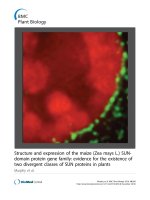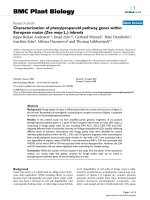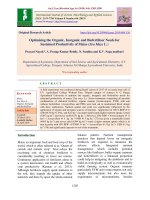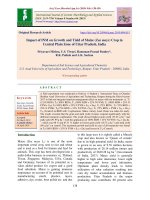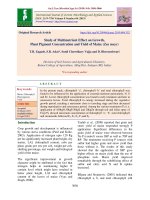Optimization of potassium fertilization for maize (Zea mays L.) in New Alluvial Zone of West Bengal
Bạn đang xem bản rút gọn của tài liệu. Xem và tải ngay bản đầy đủ của tài liệu tại đây (200.76 KB, 6 trang )
Int.J.Curr.Microbiol.App.Sci (2020) 9(7): 1518-1523
International Journal of Current Microbiology and Applied Sciences
ISSN: 2319-7706 Volume 9 Number 7 (2020)
Journal homepage:
Original Research Article
/>
Optimization of Potassium Fertilization for Maize (Zea mays L.) in New
Alluvial Zone of West Bengal
Bappa Mandal1*, Sonali Biswas2, Srabani Debnath2, Abhijit saha3,
Susmita Moi1 and Gopal Dutta4
1
Department of Agronomy, Bidhan Chandra Krishi Viswavidyalaya,
Mohanpur - 741252, Nadia, West Bengal, India
2
AICRP on Maize, Directorate of Research, BCKV, Nadia, West Bengal, India
3
College of Agriculture, Lembucherra, West Tripura, Tripura, India
4
Department of Agricultural Meteorology and Physics, Bidhan Chandra Krishi
Viswavidyalaya, Mohanpur - 741252, Nadia, West Bengal, India
*Corresponding author
ABSTRACT
Keywords
Maize, Potassium,
Yield, Net return
and B: C ratio
Article Info
Accepted:
14 June 2020
Available Online:
10 July 2020
A field experiment was conducted during kharif season of 2018 at District Seed Farm of
Bidhan Chandra Krishi Viswavidyalaya, Kalyani, Nadia, and West Bengal, India on sandy
clay loam soil having neutral in reaction with the objective of optimization of potassium
fertilization for maize in new alluvial zone of West Bengal. The experiment was laid out in
Randomized Block Design having four replications with six treatments (T) comprising
different potassium levels as 0 (T 1), 30 (T2), 60 (T3), 90 (T4), 120 (T5) and 150 (T6) kg K2O
ha-1 with recommended dose of nitrogen and phosphorus (120:60 N: P 2O5 kg ha-1).
Application of 150 kg K2O ha-1 resulted in higher plant height (304.23 cm), LAI (6.71)
grain yield (7.86 t/ha), stover yield (9.12 t/ha), net return (Rs. 59019.33/-) which were
statistically at par with 120 kg K2O ha-1 treated plots and 90 kg K2O ha-1 treated plots.
Highest B: C (2.11) ratio was observed in T 5 treatment which was statistically at par with
T6 treatment (2.10) and T4 treatment (2.04). The results showed that increase in all growth,
yield, net return and B: C ratio of crop was more pronounced up to 90 kg K 2O ha-1, but
there was no significant increase in all growth, yield, net return and B: C ratio of crop
when potash level was increased above 90 kg K2O ha-1. So, it could be concluded that
application of 90 kg K2O ha-1 is the optimum level of potassium for maize to obtain higher
yield and profitability.
Introduction
Maize is an important grain crop of the world
and it ranks 3rd after wheat and rice in area
basis and total production (FAOSTAT, 2013).
The importance of corn is due to its wide
diversity of uses. Globally, maize is grown in
184 M ha across 165 countries, with total
production of 1016 Mt and average
productivity of 5.52 t/ha (FAOSTAT, 2014).
Its production is increasing at twice the
annual rate of rice and three times that of
1518
Int.J.Curr.Microbiol.App.Sci (2020) 9(7): 1518-1523
wheat (Fischer et al., 2014). India produces
about 2% the world’s maize produce.
Karnataka is the leading producer of maize in
India producing around 16% of India’s total
Maize production and followed by Telangana
& Bihar which together contribute 20% to
India’s maize production basket. Maharashtra,
Madhya Pradesh, Tamil Nadu, Andhra
Pradesh, Rajasthan and Uttar Pradesh are
other maize producing states of India. Maize
is also gaining importance in West Bengal.
The area of cultivation of this crop is
increasing year after year. In the year 2015-16
maize was cultivated in 0.156 M ha and
recorded production of 0.720 Mt of maize
grains. The state’s contribution to national
production was about 2.74%. However,
average productivity (4615 kg/ha) was much
higher as compared to national average of
2632 kg/ha (more than 165%).
Potassium is the major nutrient required for a
variety of crops along with nitrogen and
phosphorus for their normal growth and
development. Potassium acts as macronutrient in plant growth and crop production.
It plays role in cell expansion and maintains
turgidity. It helps in osmo- regulation of plant
cell, assists in opening and closing of stomata,
more than 60 enzymes are activated by
potassium. Promotive effect has been
observed on growth, development and grain
yield in maize. It regulates photosynthesis,
protein synthesis and starch synthesis
(Mengel and Kirkby, 1996). Thus, maize
requires K as high as that of nitrogen and for
about 6 metric tons production, maize
removes 120 kg N, 50 kg P and 50 kg K ha-1
from soil.
Numerous studies on soil potassium have
been carried out in the past. But there is
enough scope to study the availability of soil
potassium for plant growth. The fertilizer use
efficiency of maize crop with respect to
individual elements is affected by its
proportion in soil. Maize genotypes respond
to potassium application contrarily due to
modification in its uptake, translocation,
accumulation, growth and utilization.
Application of K has primitive effect on
growth and development (Bukhsh et al.,
2011) and grain yield in maize (Bukhsh et al.,
2009). It not only affects the rate of
photosynthesis but also regulates transport of
assimilates in maize. So, the present
experiment was conducted to study the effect
of different levels of potassium on growth,
yield attributes, yields and economies of
maize crop.
Materials and Methods
The field study was carried out during kharif
season of 2018 at District Seed Farm (ABBlock)
of
Bidhan
Chandra
Krishi
Viswavidyalaya, Kalyani, and West Bengal.
The experimental farm is situated at 22057´ N
latitude and 88020´ E longitude with an
average altitude of 9.75 m above the mean sea
level, having neutral pH (7.2) with 253, 11.48
and 179.42 kg ha-1 of available N, P and K,
respectively. The experiment was laid out in
Randomized Block Design having four
replications and six treatments comprising
different potassium levels (T) as 0 (T1), 30
(T2), 60 (T3), 90 (T4), 120 (T5) and 150 (T6)
kg K2O ha-1 with recommended dose of
nitrogen and phosphorus (120:60 N: P2O5 kg
ha-1). Potassium applied in two split doses,
one basal and one in knee height stage and
total P was applied as basal and N was
applied as 3 split doses (1/3 at basal, 1/3 at
knee height stage and 1/3 at tasseling stage).
The plot size of 5 m x 3 m (15m2) with row to
row distance of 60 cm and plant to plant
distance 20 cm and COH (M) 8 maize variety
were used.
Fertilizers were applied as per treatments; six
different doses of K2O, N and P2O5 were
applied in the form of MOP, Urea and SSP,
1519
Int.J.Curr.Microbiol.App.Sci (2020) 9(7): 1518-1523
respectively. Data were recorded on growth
parameters (plant height, LAI) and postharvest parameters (length and girth of cob,
grain yield and stover yield) and economic
parameter (net return, B: C). Height of the
plant was recorded from 5 marked plants from
each plot and their average (treatment-wise)
was calculated. LAI of maize is calculated by
using the following formula:
Leaf area
LAI = -------------------Land area
Length of the cobs of five labelled plants
were measured from base to the tip of the cob
after de-husking and the mean value of five
randomly selected cob was worked out to
expressed in centimetre (cm). The girth of
five labelled cob was measured with the help
of vernier calliper and the mean value was
expressed in cm. The grain yield was
recorded from net plots at 120 DAS from
each plot. Cobs were collected, grains were
separated and weighed, the total weight was
recorded and expressed in kg ha-1 and the
stover weight was recorded from net plots
after sun drying and was expressed in kg ha-1.
Treatment wise cost of cultivation of maize of
one-hectare area was calculated. Cost of
cultivation included land preparation cost,
labour cost, irrigation cost, cost of fertilizers
and cost for intercultural operation. Net return
is the difference between the gross return and
the cost of cultivation. Net return was
calculated and recorded for each treatment
combination and the benefit: cost ratio is the
ratio of gross return and cost of cultivation.
Benefit: cost ratio of different treatment of the
crop was computed by following formula:
Gross return
B: C= -------------------------------------Total cost of cultivation
Results and Discussion
Effect of potassium on growth attributes
Potash (K) application significantly affected
plant heights and LAI at 90 DAS. Long
stature plants (304.23 cm) were produced at
90 DAS when potash was applied at the rate
of 150 kg K2O ha-1 which was statistically
similar to 120 kg K2O ha-1 applicator plots
(302.06 cm) and 90 kg K2O ha-1 applicator
plots (299.98 cm). The increase in plant
height with higher K doses might be
attributed to the fact that higher potassium
doses promoted plant growth, increased the
number and length of the internodes due to
more cell division and cell elongation which
in turn resulted higher plant height. Findings
of this study are in line with Ayub et al.,
(2002), Hussain et al., (2011), Bukhsh et al.,
(2011) and Aslam et al., (2004) who also
found improvement in growth parameters in
different cultivars of maize with the
application of potash. Statistical analysis of
the recorded data showed that potash (K)
application significantly affected on leaf area
index (LAI). Highest LAI (6.71) at 90 DAS
were obtained at T6 treatment, where potash
was applied at the rate of 150 kg K2O ha-1
which was statistically similar to 120 kg K2O
ha-1 treated plots (6.60) and 90 kg K2O ha-1
treated plots (6.57). The increase of LAI with
increasing level of K application could be due
to the increased photosynthetic activity of
plants and more no of leaves per plant.
Amanullah et al., (2016) reported that
maximum leaf area index was recorded for
the plots treated with the highest K level (90
kg ha−1).
Effect of different treatments on yield
attributes and yield
Yield attributes
From the Table 1 it may be stated that
different level of potassium did not
1520
Int.J.Curr.Microbiol.App.Sci (2020) 9(7): 1518-1523
significantly influenced the length of cob and
cob girth. However maximum cob length
(15.30 cm) was observed at T5 treatment (120
kg K2O ha-1.). Highest cob girth (13.86 cm)
was obtained when potash was applied at the
rate of 150 kg K2O ha-1. The mean data
revealed that cob length and cob girth
increase with increased different potassium
levels. Similar result was obtained by Hussain
et al., (2019) and Amanullah et al., (2016).
Table.1 Plant height, LAI, length of cob, girth of cob of maize as affected by different treatments
Treatments
Plant
LAI
height at at 90 DAS
90
DAS
(cm)
5.25
T1- RDF of nitrogen and phosphorus + 0 kg 283.33
potassium per ha
5.44
T2 -RDF of nitrogen and phosphorus + 30 kg 279.13
potassium per ha
5.51
T3 - RDF of nitrogen and phosphorus + 60 kg 284.66
potassium per ha
6.57
T4 - RDF of nitrogen and phosphorus + 90 kg 299.98
potassium per ha
302.06
6.60
T5 - RDF of nitrogen and phosphorus + 120
kg potassium per ha
304.23
6.71
T6 - RDF of nitrogen and phosphorus + 150
kg potassium per ha
2.12
0.22
Sem ±
6.69
0.70
CD at 5%
Length
cob
(cm)
of Girth
cob
(cm)
12.22
12.54
13.77
13.08
13.49
13.00
14.30
13.32
15.30
13.08
15.23
13.86
1.09
NS
0.42
NS
Table.2 Grain yield, Stover yield, Net Return and B: C of maize as affected by different
treatments
Treatments
Grain yield
(t ha-1)
Net
Return
(Rs ha-1)
27202.67
B:C
5.253
Stover
yield
(t ha-1)
6.863
T1- RDF of nitrogen and phosphorus + 0 kg
potassium per ha
T2 -RDF of nitrogen and phosphorus + 30 kg
potassium per ha
T3 - RDF of nitrogen and phosphorus + 60 kg
potassium per ha
T4 - RDF of nitrogen and phosphorus + 90 kg
potassium per ha
T5 - RDF of nitrogen and phosphorus + 120
kg potassium per ha
T6 - RDF of nitrogen and phosphorus + 150
kg potassium per ha
Sem ±
CD at 5%
5.947
7.416
35843
1.71
6.575
7.977
43691
1.85
7.397
8.711
54226.83
2.04
7.782
8.948
58515.33
2.11
7.861
9.125
59019.33
2.10
0.199
0.628
143.69
452.79
2517.27
7932.07
0.05
0.16
1521
1.55
of
Int.J.Curr.Microbiol.App.Sci (2020) 9(7): 1518-1523
Yield (t ha-1) as affected by different
potassium levels
Statistical analysis of the data showed that
potash (K) application significantly affected
grain and stover yield. The higher grain yield
(7.86 t ha-1) and stover yield (9.12 t ha-1) was
obtained with 150 kg K2O ha-1 which were
statistically similar to 120 kg K2O ha-1 (7.78 t
ha-1 of grain and 8.948 t ha-1 of stover yield,
respectively) and 90 kg K2O ha-1 (7.39 t h-1 of
grain and 8.71 t ha-1 of stover yield,
respectively). The results showed that
increase in grain yield was more pronounced
up to 90 kg K2O ha-1, but there was no
significant increase in grain yield of crop
when potash level was increased above 90 kg
K2O ha-1. Increased level of potassium up to
90 kg K2O ha-1 significantly improve grain
yield by providing a better source sink
relationship enabling greater synthesis and
translocation of metabolites to reproductive
organs resulting in improved yield attributing
characters, grain and Stover yield of maize.
The results are in agreement with the findings
of Bereez et al., (2005), Choudhary and Malik
(2000).
Effect of potassium levels on net return and
B: C ratio
The potassium levels significantly influenced
the net return and B: C ratio of maize.
Maximum net return (59,019.33/- ha-1)
obtained fromT6 treatment which was
statistically at par with treatments T4 and T5
treatment and B: C ratio (2.11) was obtained
in T5 treatment. Which was statistically at par
with treatments T4 and T6 treatment? The
mean data revealed that net return and B: C
ratio increased significantly with the increase
in potash level up to 90 kg K2O ha-1. This
might be due to higher grain and stover yield
of maize under these treatments.
In conclusion from the experimental results, it
could be concluded that application of 90 kg
K2O ha-1 is the optimum level of potassium
for obtaining higher grain yield, economic
benefit of maize and supplementing balance
nutrition to the maize during Kharif season
under new alluvial zone of West Bengal.
Acknowledgement
We sincerely acknowledge ICAR-IIMR,
Ludhiana for financial support and field staff
for providing facility for conducting this
research. The support provided by Directorate
of Research, BCKV, Nadia, and West Bengal,
India for this study also acknowledged.
References
Amanullah, A. I. and Irfanullah, Z. H. 2016.
Potassium management for improving
growth and grain yield of maize (Zea
mays L.) under moisture stress
condition. Scientific reports. 6.
Aslam, M., Hussain, M. and Nadeem, M. A.
2004. Comparative efficiency of
different mungbean genotypes under
Agro‒climatic conditions of Bhakkar.
Pakistan J Life Soc Sci. 2(1):51‒53.
Ayub, M., Nadeem, M.A. and Sharar, M.S.
2002. Response of maize (Zea mays L.)
to different levels of nitrogen and
potassium fertilizer. Asian J Plant Sci.
4(1):352‒354.
Bereez, K., Kismanyott, T. and Debreczeni,
K. 2005. Effects of organic matter
recycling in long term fertilization trials
and
model
pot
experiments.
Communications in Soil Science and
Plant Analysis. 36: 192-202.
Bukhsh, M. A., Ahmad, R., Ishaque, M. and
Malik, A. 2009. Response of maize
hybrids to varying potassium application
in Pakistan. Pak J Agric Sci. 46:179–
184.
1522
Int.J.Curr.Microbiol.App.Sci (2020) 9(7): 1518-1523
Bukhsh, M., Ahmad, R. and Iqbal, J. 2011.
Nutritional
and
physiological
significance of potassium application in
maize hybrid crop production. Pakistan
J Nutri. 11(2):187‒202.
Chaudhry, A. and Malik, J.K. 2000.
Determination of optimum level of
potash and its effect on yield and quality
of maize. Pakistan Journal of Biology
Science.1(1): 13-16.
Faostat., (2013). Food and Agriculture
Organization Statistics. Food and
Agriculture Organization Statistics Data
Base, Agricultural production indices.
Roma,
Italy.
DOI:
/>/O/QC/E (Accessed on 20 July 2015).
Faostat., (2014). Production-Crops data. Food
and Agriculture Organization of the
United
Nations.
http://
www.faostat.fao.org/site/567.
Fischer, R. A., Byerlee, D. and Edmeades,
G.O. 2014. Crop yields and global food
security: will yield increase continue to
feed the world? ACIAR Monograph No.
158, Australian Centre for International
Agricultural Research, Canberra, xxii
+634 pp.
Hussain, M.Z., Kumar, M., Singh, D. and
Yadav, S. 2019. Effect of Different
Levels of Potassium on Yield and Yield
Attributes of Kharif Maize (Zea mays
L.). Int.J.Curr.Microbiol.App.Sci 8(1):
2054-2060.
Hussian, F., Malik, A.U. and Haji, M.A.
2011. Growth and yield response of two
cultivars of mungbean (Vigna radiata
L.) to different potassium levels. J Anim
and Plant Sci. 21(3):622‒625.
Kumar, R., Srinivas, K. and Sivaramane, N.
2013. Assessment of the maize situation,
outlook and investment opportunities in
India. Country Report – Regional
Assessment
Asia
(MAIZE-AICRP),
National Academy of Agricultural
Research Management, Hyderabad,
India.
Mengel, K. and Kirkby, E.A. 1996.
“Principles of plant nutrition” book
published by Panima Publishing
Corporation, New Delhi/Bangalore. pp:
427-446.
How to cite this article:
Bappa Mandal, Sonali Biswas, Srabani Debnath, Abhijit saha, Susmita Moi and Gopal Dutta
2020. Optimization of Potassium Fertilization for Maize (Zea mays L.) in New Alluvial Zone
of West Bengal. Int.J.Curr.Microbiol.App.Sci. 9(07): 1518-1523.
doi: />
1523
